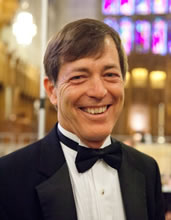The rich programming of this concert by the Brevard Music Center‘s Camerata, an auditioned all-college-student orchestra, gives one an inkling of the fine array of educational opportunities at the Center throughout the summer. Performed in Brevard College’s Porter Center and conducted by Maestro Ken Lam, BMC Resident Conductor, the concert opened with Stravinsky’s Concerto in E-flat for Chamber Orchestra (“Dumbarton Oaks”), and was followed by Mozart’s “Exsultate, Jubilate,” K.165, featuring Grammy Award winning soprano Ilana Davidson. The evening concluded after an intermission with Beethoven’s Symphony No. 1 in C, Op. 21.
The Stravinsky, a neo-classical concerto grosso inspired by Bach’s works (especially his third Brandenburg Concerto), was commissioned by Mr. and Mrs. Robert Bliss to celebrate their 30th wedding anniversary and premiered in May of 1938 in the magnificent music room of Dumbarton Oaks, a magnificent estate near Washington, DC. The piece is not an easy concert opener for a student ensemble, as its chamber dimensions utilized the fewest players of the concert – 3 violins, 3 violas, 2 cellos (the score calls for 3), 2 double basses, flute, clarinet, bassoon, and 2 French horns. Furthermore, it was apparent that the score was the least familiar to the players. True to Stravinsky’s neo-classical style, the opening movement bustled with incessant motion, shared among the players often in tight imitative writing. The cohesion of sound centered within each section – strings or winds – and the players gave this movement a measured, careful reading. The second movement Allegretto sounded more congenial, as the droll short phrases of the strings were answered frequently with a single, comic note in the bassoon, then other winds. The bustling final movement with its many rhythmic intricacies appeared to require total concentration from each performer, and with their eyes trained intently on their music, the movement sounded very studied, lacking the sense of easy fluidity one will hear from these same players in a few years.
Additional players joined those onstage to perform Mozart’s great motet of his youth (he was 16 when he composed this motet in Milan, for the castrato Venanzio Rauzzini). Soloist Ilana Davidson is a very attractive singer with a lovely, lyrical vocal quality that blended extremely well with the small orchestra and projected effectively into the hall. While there were definitely high points in the performance (notably the vocal cadenzas within the outer sections, each executed with technical finesse and lovely musicality), there were some issues with ensemble and tempo. With the opening section of the motet (“Exsultate, Jubilate”), I wasn’t convinced she was comfortable with the tempo and appeared to be urging Lam to go faster. The string playing in this movement was fine and well balanced with the singer, but in the third section (“Tu, virginum corona”) the balance among the strings was off, with the violins frequently overshadowing the principal theme when it was played by the violas. The concluding “Alleluia” is frequently sung at a faster tempo, so this slower rendition sounded weighted and somewhat worked. Ms. Davidson will be the featured soloist on July 25 with the BMC Orchestra (Keith Lockhart, conductor) in the Mahler Symphony No. 4.
The runaway favorite of the concert was the Beethoven Symphony No. 1. The number of musicians was amplified yet again to fill the stage with a full symphonic complement. Lam is a vibrant and knowledgeable conductor who led the piece from memory, thus maximizing his eye contact with and cueing of the players. There was a new synergy within the ensemble and with their sureness of intention, the performance was informed and thrilling to hear. The tempi were spot on, and the intonation and ensemble finely tuned. Moreover, the players captured brilliantly Beethoven’s enormous range of expression, from the titanic outpourings within the first movement, to the beautiful, lyrical phrasings within the second. The third movement was played like a proper scherzo with its extroverted ebullience. The Haydnesque finale was a study in comedy and unbridled joy, with Lam leading the fun by casting quizzical looks at the violins playing the opening halting scalar figures. This was a performance to remember, truly and appropriately “an art of strong emotions rather than of social graces,” and the audience responded with a standing ovation and three calls for Lam’s return to the stage.
The festival continues through August 3. For details, see our calendar.











